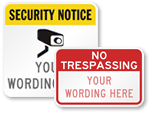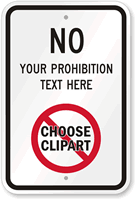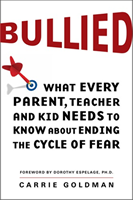1
How did you become a voice in the anti-bullying community?
My daughter, Katie, when she was starting first grade, she was a huge Star Wars fan, she still is. She went with me to Target to pick out her lunch bag and backpack. She picked out a Star Wars water bottle and a Star Wars backpack, and she was very excited every day to go to school and bring it. Then there came a day in November 2010, when she told me she did not want to bring her Star Wars water bottle anymore. It set off my parental radar because it seemed odd; it was a change in her behavior without a good explanation. When I pressed her about it, she started to cry, and she told me that the boys were surrounding her at lunch, at recess, and at her locker, and they were making fun of her and telling her that girls cannot like Star Wars, that it is only for boys.

I wrote an article about what was happening for my blog, Portrait of an Adoption, and the response was just nothing short of astonishing. People from around the world sent Katie messages and support and told her it was OK to like what you like and be who you are. It was so unbelievable that I started researching bullying in our culture, because everyone who wrote a message of support to Katie talks about their own experiences with having been teased or taunted. I decided to research why we have so much bullying in our culture and what we can do about it. That is what became the foundation for the book.
Do you speak about how the experience started from a gender issue?
Yes, it started from the gender issue.
2
Through your research, is it more thematic that bullying comes more from boys than it does from girls?
Bullying comes pretty equally but it happens in different ways. Girls tend to do more of the "Mean Girl" syndrome; it is a little more underhanded. There are more rumors and there is more relational aggression and aggressive exclusion, whereas with boys, you see more of the physical bullying: hitting and using physical aggression to intimidate. Although both genders bully, it manifests in different ways.
3
You also highlight that bullying starts in the first grade, when children are more cognizant?
It actually starts before then. That was the title of my
blog post at the time that I wrote about Katie. Bullying can start almost as soon as children are old enough to develop opinions. Children who grow up in houses with parents who are very dismissive or who carry strong stereotypes about other people, the children will pick up on that. Even as young as in preschool we see children acting in bullying ways around other peers. It really starts as soon as they can learn to talk.
4
Are there common characteristics of bullies?
With children who act as bullies, it is not uncommon to find that they come from families where they have parents or siblings who act as bullies. I do not know if I would say that bullying is genetic, but certainly the behavior is learned. If you are being raised in a house where the style of discipline is authoritarian or military-style, then kids are more prone to act aggressively. We see that parenting styles and teaching styles do have an effect on bullying. There are also a lot of associations between bullying and different psychological profiles. There was a study that showed children who were classified as bullies were at elevated risk later in their lives for antisocial disorders, anxiety, or depression. Children who were victimized have an elevated risk for anxiety disorders, post-traumatic stress disorders, and depression.
5
You also mention scans have shown that bullying actually damages brain function.
It does. There have been brain scans that show that when you are victimized, the repetitive bullying starts to change the way that your brain functions, and you lose the ability to interpret situations down the road that might not be hostile as safe. You start feeling threatened even by the smallest of actions or confrontations. One of the many people I interviewed for the book explained to me that as a result of having been severely bullied, he had post-traumatic stress syndrome. If anyone ever questioned his work in the workplace, even though it was a normal interaction, his response was to clam up and become paralyzed with fear, and he perceived it as he was being attacked because his brain no longer was able to differentiate between regular questioning and someone taunting him.
6
Recent accounts, such as a book written by a former Goldman Sachs executive who recanted how he was victimized starting out as an intern, promote another form of anti-bullying awareness. Are there other segues from bullying in childhood to bullying in the workplace?
A lot of people take the approach of telling the victim to just fight back harder and then the bullying will stop. That does not show a rich appreciation for the dynamics of bullying relationships. In most bullying relationships, the person who is being picked on is almost paralyzed by fear of reporting what is happening, of retaliation, or drawing further ire from the bully. Instead of being able to fight back, they ride it out in silence and suffer, and we see that continuing into the workplace. People who are being bullied in the workplace are usually so frightened of retaliation or of the workplace coming out and just blaming the victim that they are less likely to make a report.

There is a group called the Workplace Bullying Institute, which does a great amount of research into workplace bullying. They are trying to help change that culture of blaming the victim, and trying to make it more acceptable for employees to actually voice it when it is happening and find someone to help them. It is that same message that we have to teach with kids starting young, that it is not a bad thing to report it, and you should not live in fear of retaliation. For the people who are doing the bullying, that they should not assume that they can just get away with it, intimidating to silence their victims.
7
So, promoting a culture that is aware of the real effects of bullying as children are growing up is a collaborative effort?
Right. There are a couple different things. When you are faced with bullying it is not a solution that comes from any one party. You cannot tell the victim, "
stand up for yourself," and assume the problem will be done. You cannot tell the bully, "We need to teach you empathy," and assume the problem will be done. You cannot tell the schools, "You have to do a better job watching out" and the bullying will be done. It comes from all of these places; it all has to work together. It is a collaborative effort and a cultural one, too. Kids get messages of aggression from the media, music, and reality TV shows that teach them the best way to get ahead is to throw someone under the bus. Everyone has to work together. An important component of that is trying to provide the child who’s being targeted with some strategies to use in the moment that the aggressions happen.

There are different strategies you can use when you’re being verbally taunted, things you can say and to try and comfort yourself, to try and turn it around and take the problem from the bully.

There is a great book by Judy Friedman called
Easing the Teasing. I worked with her to incorporate some of those strategies into the book that I wrote,
Bullied: What Every Parent, Teacher, and Kid Needs to Know About Ending the Cycle of Fear. Some of the strategies can be used by very young children. It could be something as simple as agreeing with the teaser. By agreeing with the teaser, I mean that if somebody is picking on a child and saying, "You are fat," if the child has a comfortable self-image and knows that they are a larger child, then the kid might be able to say, "You are right. I am overweight, but I am a great person." If that is the reaction that the bully gets instead of the kid crying, tremoring in fear or running away it often will stop the bully because the power imbalance has been taken away.

If someone is saying to you "You are fat," and your response is, "I am bigger, but I am great," they are not getting the reaction that is going to feed them to continue to torture you and they will walk away. An important step when agreeing with the teaser is to be comfortable and confident with who you are, without it making you feel bad. That is why we teach cognitive restructuring, which is where you take the statement that someone is throwing at you, and you say to yourself, "This kid who is telling me I am fat is trying to make me feel bad, but what I know is that he or she is simply choosing to be mean. I am a good person, I am doing nothing wrong here, and I do not deserve this. I am not to blame for this. I am just living my life. I know that what is happening is not a reflection of who I am." The kid has to be able to first talk themselves through the situation so they can then respond to the taunter.
8
Having a quality line of support is important for victimized children, certainly at home, to understand that they aren’t to blame for being bullied.
It is interesting actually, that you mention the importance of the home. There is no way to stress how important it is for the child to get acceptance at home. Studies show that children who are most at risk of taking their own lives when they’re being bullied are the kids who are not only being bullied at school but do not feel that they are being accepted at home. This is a very common, sad outcome in the gay and lesbian community. If you have a child that has been rejected by his or her family because they are not comfortable accepting their child’s differences, and then that child is also being rejected at the school, community, or by society, those are the kids who enter at elevated risk for feeling hopeless and like they have nothing. If you have a child who is being ostracized at school for being different, but at home they are getting messages of support, love, and strength, those kids do much better.
9
I would like to hear more about cyber bullying. You say at least one out of four children is victimized online.
Yes, cyber bullying is by far the new biggest issue. It makes the mean people meaner, and it takes the people who may never have been mean before and hides them behind a cloak of anonymity. For example, let’s say a situation 50 years ago where a group of kids were calling mean names to a girl. There might be some kids standing around and watching, and that is all they would do. Now what happens is kids see others writing something similar on a girl’s Facebook page, and then 500 additional people go to her page and also write it. People who 50 years ago may not have dared say something like that to someone’s face are now hiding behind their computer screen and writing it. Then you have the children who are being bullied go to their Facebook page, and see hundreds of vicious messages from people and feel completely overwhelmed. Cyber bullying is an intense phenomenon, and it really speaks to the worst part of human nature. Teenagers live for their social connections. If they are being attacked through those social connections, it can truly feel life ending.
10
What strategies can we employ to fight cyber bullying?
I look at it as a two-step thing. You can prevent the content involved in cyber bullying. Then there is a wave of actions you take if cyber bullying already happened, and what you do to make it stop. In the preventative phase, parents can encourage children never to share their passwords, because kids have friendship breakups as well as relationship and romantic break ups. When someone has your password, they are in a position where they can impersonate you, hack into your account, and do things on your behalf that you would not have done. A lot of cyber bullying starts off when a kid has a "frenemy" or someone who decides that they want to get back at them for something.

Also, encourage kids to never talk to strangers online about sex, because anything that you write, say, or do is replicable. You may send one photo, one text of yourself in a compromising position to a boyfriend or write one line about another person in a private Facebook page, but anything can be copied and pasted. We tell kids if there is something that is truly private, don't use a social media site to get that message to someone, rather tell someone in person. There is no true delete button, and it is very hard to erase a mistake online.

We tell parents that they should be allowed to monitor their children’s usage. You should be friends with your kid on Facebook. You should be able to verify that they’re friends with real people, and see what sites your kid has been visiting. Put parental controls on the computer, it is very normal and natural for kids to be curious about things like sex. It is very normal and natural for them to look it up on Google. When we were all little, I am sure that everyone looked in the dictionary and looked it up the word "sex." Now, eight, nine or 10year-olds can encounter things that are very inappropriate for them. Parents have to monitor their computers better. It doesn’t have to be Big Brother, but it can be an acknowledged situation. I do not think parents should sneak around behind their kids. I think they should say to them, "The computer’s a privilege, but the fact is that you can come into contact with things that we believe are harmful, so we want you to know we are going to be checking." You do not want your child to feel like you do not trust them, but at the same time, you want them to know that you are monitoring. These are all preventative steps you take along the way.
11
What should you do if your child is already being cyber bullied?
If it is too late and your child is already being cyber bullied, collect evidence, because most schools, police stations, or administrations at work cannot do anything unless they have proof of evidence that it happened. Take screenshots, save them and print them, then delete it. Delete it, because no kid should have to keep looking at that. Block people from coming back to your page, and ban and report users who are abusing a social networking site. Once you have that evidence, if you can send an email to the administrator of the site and you can attach the file that has the pictures of what has been sent to your child, there is a good chance that you can get one of these social networking sites to ban a user who is being abusive. If your school is not taking it seriously, you can go to the police. It is illegal to harass and intimidate someone through the computer.

The final, most important thing is to give your child the message that everyone makes mistakes, and that it’s OK. The worst case scenarios happen when a child makes a mistake online. This happened to a 15year-old girl in Canada, she flashed someone online, and then he started black mailing her; he made a website with the photos. She was frightened and instead of going to her parents and saying, "I made this mistake and now it is blowing up", she just kept concealing it because she was afraid to tell. The situation just kept getting worse and it kept blowing up, and she ultimately did take her life. What we want to tell our kids is, if you did something stupid online and now someone is trying to use against you, please come tell us. We would always rather that you come tell us and let us help you earlier than wait until later. It is very important for parents to let their kids know that we are on their side.
12
When you speak about the big issue of cyber bullying and how it poses a very harmful threat on children, you also have something that you call cyber supporting. How does society endorse this in combating cyber bullying, and bullying in general?
Cyber supporting is a really amazing phenomenon that we do not hear enough about because we are always hearing the bad news stories from the media. Cyber supporting is what happened with my little girl where people from all over raced to write messages of support, love, empathy, and concern when they heard about what was happening. There are other sites that are specifically cyber supporting sites. There is
It Gets Better, Dan Savage’s site for kids who are gay, lesbian, bi-sexual, and transgender where thousands of people have uploaded YouTube messages saying, "Hang in there. It is going to get better." There are a lot of great cyber supporting sites for people who are suffering from illnesses, people who are members of a group that might be more marginalized in society, so what you do is you just seek out people who will help you. You go into a community, you find a community of people who are like you, who have similar interests as you do, so that you do not feel ostracized. In cyber supporting you find a way to connect to each other, you have your enlisters, you have your email groups, you make pages, there are many cyber supporting-type groups on Facebook. Great, wonderful groups where people come together for the sole purpose of buffing each other up instead of trying to tear each other down.

As a parent, you know none of these groups are monitored so it is certainly a place where you want to check in if your child is a part of a cyber supporting group, because like with anything in society, there are people who are potentially stalkers preying on someone’s weakness by finding a site like that and pretending to be a member when they are not. If your child meets anyone through a cyber supporting site, I think it is always worth checking out and verifying that the person is who they say they are. There are ways for people to connect and feel a sense of belonging through the internet that they can turn those into real lasting in person friendships that make a real difference.
13
I understand that it is difficult for some schools to deal with cyber bullying. However, are schools now emphasizing cyber supporting as well?
There are a number of sites out there that schools can be a part of, and I list them in my book, in one of the chapters about media and technology. Schools, as a whole, can create safe social networking groups for their school, for kids, where they are provided with a logon and password, there is a moderator, and kids can practice safe social networking interactions. Schools are doing that, but like you said, not every school has access to technology. Most schools block sites like Facebook or Twitter for the purpose of not having kids distracted during education. I believe that every school now has a duty to teach children about safe internet usage. I believe that it should be part of the curriculum, like anything else at school. Our kids are going to spend hours and hours of their lives on the internet. Alongside teaching them their sums, math, diagramming sentences, and second language, we need to teach them the languages of computer literacy. Schools can get involved in that, even if you do not have widespread computer access you can still have discussions with children about the computer and how it can be a wonderful place and how it can be a dangerous place.
14
Beyond cyber bullying, what role are schools playing in combating bullying on the playground and beyond?
Every school is different. One of the things that is complicated about anti-bullying is that there is no one national approach to it, so each school has to assess for itself what is going on. Schools are, by and large, taking a keen interest in this. There are a number of very good, strong researched-based programs out there and I listed them; programs like PBIS, Second Steps, and Steps to Respect. There are programs out there for schools to use, a lot of schools are taking the approach where they start with social emotional learning and teaching those skills to kids, and that is a great way to start, particularly in the early grades; just talking about empathy, about feelings, and about people who are different. A lot of schools use things like PBIS, which is Positive Behavior Intervention and Supports, where there are different tiers of intervention, and children who prove to be more at risk for bullying activities or more at risk for being targeted, receive more structured and individualized psychological care, but still participate in school wide activities. A lot of these whole school approaches, which were pioneered by Dan Olweus, are a great way to involve the community.

A word of advice about school programs is that your school can say that it has an anti-bullying program and it really will not be anything unless the teachers, parents, and principals live those values day-to-day in their classrooms. Just saying that you have an anti-bullying policy does not at all mean that your school will not have bullying. The way to reduce bullying in your school is for your teachers to buy into it and to believe in it, and believe that there are no exceptions around blaming the victim. You have to have a place where when the teachers witnesses cruelty, they stop and they call it out. You have to have a school that knows that the bullying tends to happen at recess, lunch, or in the halls during the unmonitored times and places, and that the school takes teams to put more connected individuals into the halls or have more connected people watching what is going on at a recess and at lunch. The school has to live the anti-bullying values day-by-day.
15
At Smart Sign, customers come to our No Bullying signs looking for reminders to promote bully free environments, such as in schools. What do you think the efficacy of no bullying signs as part of a larger campaign to build awareness is? As an artist as well, are there certain types of art or legends that you believe can be used to combat bullying?
I think that having a sign and putting it out there is a great start, because it puts people on alert that it is a safe place, this is not where this is accepted. I think for people to regard the sign with any credibility you have to then make sure that the people who work there are onboard with follow-up. You do not want a situation where there’s a sign that says, "Kindness rules. No bullying here," and then all the parents say when they make a report of it, the teacher or the principal says nothing. There is that bit of due diligence in saying to someone, "This is great that you are going to buy this sign, but what else you do have in place?" It would be awesome if you could have it on your website, even a link to information, research, and programs for schools or workplaces so that when they buy a sign that says, "No bullying allowed," they can also provide their employees or students with a link to some information about what to do. For example, how to turn from a bystander to a witness, how to turn into an ally, and steps to take if you witness bullying. Back up the sign with some actionable items.















 What are the foundations of school bullying, workplace bullying, and cyber bullying? What are the best ways to prevent bullying? How can we create acceptance and anti-bullying awareness in our community? MySecuritySign.com spoke with Carrie Goldman to answer some of these important questions.
What are the foundations of school bullying, workplace bullying, and cyber bullying? What are the best ways to prevent bullying? How can we create acceptance and anti-bullying awareness in our community? MySecuritySign.com spoke with Carrie Goldman to answer some of these important questions.